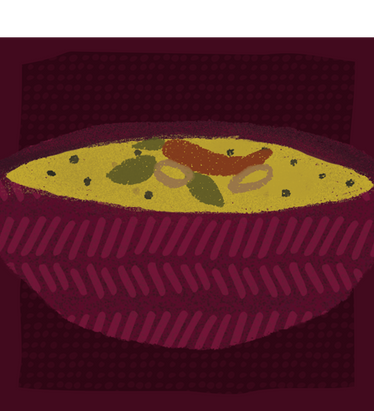
Resources
Our Flavorful World: Dal
Dal aboard! Sarah Thomas shows us how dal and pulses are enjoyed around in the world in a variety of dishes and cultures.
I have always had a soft spot for dal. It’s one of the first things I can remember eating, and also watching my mom cook. I remember my little brother loving it so much as a toddler that when we’d go to restaurants, he’d sweetly ask the waiter for “wice and dal” as his first choice, no matter what type of restaurant we were at. There’s such an air of comfort to dal as a broad category for me, because I know every family in India has their own version— so even if it’s not the same as the version I grew up eating, whenever I eat any type of dal, I feel at home.
Dal is not just one thing. Dal is a catch-all Hindi word for pulses, which include dried beans, lentils, peas, etc. Dal is also the word used for the dishes prepared with said pulses. India consumes roughly half of the world’s pulses— there are hundreds of different kinds of legumes and pulses used all over the subcontinent, and hundreds more preparations of them!— but they are diet staples throughout the Mediterranean, the Middle East, North Africa, and South America. And of course they are! They’re magically nutritious, high protein/fibre and low fat and cholesterol. They are cheap, readily available, and easy to cook. As a crop, pulses are excellent for nitrogen fixation, which is good for the crop cycle and the planet. They are among the earliest cultivated crops, probably originating over 10,000 years ago in the Middle East. And as if all of that wasn’t fascinating enough—the preparations of pulses and legumes around the world are as varied as they are delicious. Here are just a few examples for you to try with your family.
From the Indian subcontinent
I’m sure someone has compiled a definitive list of all the different types of dal prepared around India and Pakistan, but here I’ll mention just a few. The magic of most Indian dal preparations isn’t in their base prep, which is usually very simply simmered, maybe with some turmeric, till soft. The fun part comes in the infusion of flavor— the tempering of spices in hot oil, which are then poured sizzling into the dal and stirred in right before eating it. Every part of India, and every family, has their own spices that they use for this tadka/chhonk/vagar/etc. In Kalamata’s Kitchen, you’ll find a map listing some of the words used for this process all around the subcontinent!
Dal Khichdi - Often the first solid food Indian babies consume (and still one of my favorite things…) khichdi is a softly flavored mixture of very soft rice and dal. And while the whistle of a pressure cooker can be heard in kitchens spanning the subcontinental diaspora, I often make khichdi in my Instant Pot to have quick, healthy comfort in minutes.
Kohlapuri Akkha Masoor dal - This is a dal preparation from the state of Maharashtra made with whole red gram (masoor). This fragrant dish includes roasted and ground sesame seeds, coconut, as well as either Lasun or Goda masala as the spice mix. These are typical Maharashtrian blends that are used for tempering.
Dal Makhani - This is a hugely popular dish with a fascinating history. The original dish was made in Western Punjab, in what is now Pakistan. The dish we know was likely created in its current iteration in New Delhi, by Kundan Lal Gujral, who helped popularize tandoori cooking in Delhi. By adding cream and butter to the more traditionally Peshwari dal preparation, he popularized the luxurious, rich, addictive version of the dish readily found in restaurants.
Parippu vada - I mentioned a lot of stew-like preparations of dal, but would be remiss to exclude one of my favorite Kerala-snacks, the humble parippu vada! This is a fried street-food snack made of chana dal, spices, and curry leaves. You can smell them frying on streets all over Kerala, and I am drooling just thinking about the spicy/salty/curry-leaf loaded crunch of them.
Persian
Adas Polo - This is an aromatic dish that is a staple of many Persian tables. It is simple to prepare in base form, and just as easy to plus up. The main ingredients are rice and lentils, though typically it is prepared with raisins, onions, barberries, butter, cinnamon, saffron, and walnuts. It can be served with or without meat, and often with something to sweeten it slightly, like dates or sugar. It is a perfect example of why I find Persian cuisine so fascinating— such an incredible variation of scent, texture, and flavor in every bite.
Ethiopian
Misir Wot - While the spices are different, Misir wot is one of those lentil dishes that always makes me feel that dal-inspired homey feeling. Misir wot is the definition of slow-food— according to Meaza Zemedu of Meaza Restaurant in Falls Church, “to make a stew, you need to have time.” The onions are cooked down to a rich deep color, as are the traditional Berber spices. The fragrant mekelesha spice blend has one of those scents you could live in.
More to try!
- Lentils de puy from France
- Menestra de lentejas from Ecuador
- Mujadara from Lebanon
- Cotechino with lentils from Italy

